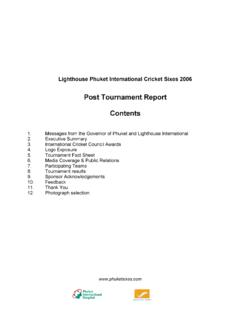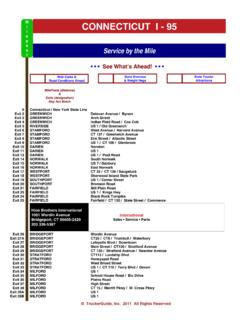Transcription of New mandatory training for the carriage of …
1 New training requirements for the carriage of dangerous Goods in containers By John Wilson, FICS It is likely that everyone involved in the maritime industry, will have seen a photograph of a silouette of a ship against the backdrop of a beautiful seascape horizon in fading skies, with bright streaks of white light shooting up to the heavens from the ship. The photograph in question was not an advert for the latest Hollywood blockbuster movie, but the real life situation of multiple explosions and fires on board an ocean going container ship, as one by one, the contents of the containers heat up, catch fire and in some cases explode, causing extensive damage to the ship and cargo. Perhaps the only benefit from the incident, and other such catastrophic container fire and explosion incidents like it in recent times, is to highlight a problem that has always existed in the container industry the fact that during the normal course of the operation of the ship, the Master of a container ship, unlike any other type of ship carrying dry cargo, does not actually see what cargo he has agreed to carry.
2 The containers are closed and sealed before they arrive at the load port, and are not opened until they arrive at their final destination ashore. SOLAS and the IMDG Code Such incidents have often been found to be due to misdeclared dangerous goods or undeclared dangerous goods, in shipping containers. dangerous goods , in the maritime world, are defined in SOLAS ( , Part A, Reg1) as The substances, materials and articles covered by the IMDG Code The IMDG Code is the IMO publication, the International Maritime dangerous Goods Code , and SOLAS states ( , Part A, Reg3), that The carriage of dangerous goods in packaged form shall be in compliance with the relevant provisions of the IMDG Code . The IMDG Code, states ( , Ch. , Section ) The provisions contained in this Code are applicable to all ships to which the International Convention for the Safety of Life at Sea, 1974 (SOLAS 74), as amended, applies and which are carrying dangerous goods as defined in regulation 1 of part A of chapter VII of that Convention.
3 The IMDG Code contains details of thousands of different types of substances and states what hazards they pose, such as whether or not they are flammable or corrosive, and what precautions need to be taken in order to safely carry the substance inside a shipping container for carriage on board a ship. Given the complexity of shipping such substances, and the large amount of information that is therefore required to be included in the Code, the book is not, at first viewing, a very easy book to read and understand. A user of the Code requires a certain amount of familiarisation and hands on practice using the Code, in order to be able to use it quickly and efficiently, and most importantly, to then apply the guidance correctly when considering the shipment in question.
4 Certification Once the goods have been approved for their suitability for shipment in a container , and they have been properly packaged and then properly stowed in the container , and the container has been labeled to indicate that dangerous goods are stowed inside, the dangerous Goods Form, also known as the dangerous Goods Transport Document, or dangerous Goods Note, must be completed. This must contain the wording of the Shipper s Declaration. Similarly, the container / Vehicle Packing Certificate needs to be completed and must contain the wording of the Packer s Declaration. These two declarations can be one document The Shipper s dangerous goods declaration must contain the following wording : I hereby declare that the contents of this consignment are fully and accurately described above by the Proper Shipping Name, and are classified, packaged, marked and labeled / placarded, and are in all respects in proper condition for transport according to applicable international and national government regulations (Ref: IMDG Code Part ) Packer s Declaration : The IMDG Code requires that those responsible for packing the container must certify that the operation was carried out in accordance with the following conditions : 1.
5 The container / vehicle was clean, dry and apparently fit to receive the goods. 2. Packages which need to be segregated in accordance with applicable segregation requirements have not been packed together onto or in the container / vehicle (unless approved by the competent authority concerned in accordance with ) 3. All packages have been externally inspected for damage, and only sound packages have been loaded. 4. Drums have been stowed in an upright position, unless otherwise authorized by the competent authority, and all goods have been properly loaded and, where necessary, adequately braced with securing material to suit the mode(s) of transport for the intended journey. 5. Goods loaded in bulk have been evenly distributed within the container / vehicle.
6 6. For consignments including goods of class 1 other than division , the container / vehicle is structurally servicable in accordance with 7. The container / vehicle and packages are properly marked, labelled and placarded, as appropriate. 8. When solid carbon dioxide (CO2 dry ice) is used for cooling purposes, the container / vehicle is externally marked or labelled in a conspicuous place, such as, at the door end, with the words : dangerous CO2 (DRY ICE) INSIDE. VENTILATE THOROUGHLY BEFORE ENTERING . 9. A dangerous goods transport document, as indicated in , has been received for each dangerous goods consignment loaded in the container / vehicle. Note : The container / vehicle packing certificate is not required for portable tanks. (Ref: IMDG Code Part ) New mandatory training Provisions for IMDG Code Despite having the IMDG Code and SOLAS, accidents on ships and in ports involving dangerous goods in containers still take place.
7 Why is this? Very simply, the major reasons fall into two categories : dangerous cargoes are intentionally or unintentionally not properly declared. The required packaging, segregation, and stowage requirements are not followed. At present, application of the IMDG Code is mandatory BUT the sections for training are only recommendatory . Whilst some companies will ensure training is given, the standards of the training can vary greatly, and then there are other companies who may not provide any effective training at all. IMDG Code Amendment 34 08 Recognizing there is a lack of training / knowledge in the industry about the proper carriage of DGs in containers the IMO has now sought to improve the situation, by way of IMDG Code Amendment 34 08, and IMO (84) Resolution.
8 New mandatory training Provisions were authorized on 1st January 2009, and become mandatory from 1st January 2010, such that with effect from 1st January 2010 : Shore based personnel engaged in the transport of dangerous goods intended to be transported by sea shall receive training in the contents of dangerous goods provisions commensurate with their responsibilities. (IMDG Code 2008 Chapter ) training under supervision and refresher training required Entities engaging shore based personnel in such activities shall determine which staff shall be trained, what levels of training they require and the training methods used to enable them to comply with the provisions of the IMDG Code. This training shall be provided or verified upon employment in a position involving dangerous goods transport.
9 For personnel who have not yet received the required training , the entities shall ensure that those personnel may only perform functions under the direct supervision of a trained person. The training shall be periodically supplemented with refresher training to take account of changes in regulations and practice (IMDG Code 2008 Chapter ) mandatory training will apply to shore based personnel who conduct the following functions: Classify dangerous goods and identify Proper Shipping Names of dangerous Goods. Mark, label or placard dangerous goods. Accept dangerous goods in transport. Prepare dangerous loading / stowage plans. Carry dangerous goods in transport. Enforce or survey or inspect for compliance with applicable rules and regulations.
10 Otherwise involved in the transport of dangerous goods as determined by the competent authority. Each person shall receive General awareness/familiarization training , which is designed to provide familiarity with the general provisions of dangerous goods transport provisions. Each person shall also receive Function specific training , which is detailed training concerning specific dangerous goods transport provisions which are applicable to the function that person performs. Increased knowledge of the procedures involved in shipping dangerous goods, should lead to a reduction in accidents, losses and insurance claims, by hopefully reducing the occasions on which dangerous goods are unintentionally misdeclared, packed or secured. However, increased training will not stop the occasions when dangerous goods are intentionally misdeclared, intentionally not declared or knowingly incorrectly packed or secured.





